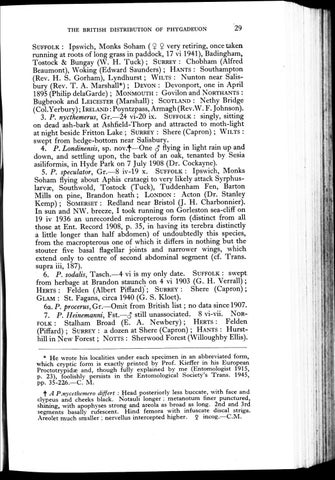THE BRITISH DISTRIBUTION OF PHYGADEUON
29
: Ipswich, Monks Soham ( $ ? very retiring, once taken running at roots of long grass in paddock, 17 vi 1941), Badingham, Tostock & Bungay ( W . H. T u c k ) ; SURREY : Chobham (Alfred Beaumont), Woking (Edward Saunders); H A N T S : Southampton (Rev. H. S . Gorham), Lyndhurst; W I L T S : Nunton near Salisbury (Rev. T . A. Marshall*); D E V O N : Devonport, one in April SUFFOLK
1 8 9 5 ( P h i l i p d e l a G a r d e ) ; MONMOUTH : G o v i l o n a n d NORTHANTS :
Bugbrook and L E I C E S T E R (Marshall) ; SCOTLAND : Nethy Bridge (Col.Yerbury); IRELAND : Poyntzpass, Armagh (Rev.W. F. Johnson). 3. P. nycthemerus, Gr.—24 vi-20 ix. S U F F O L K : singly, sitting on dead ash-bark at Ashfield-Thorp and attracted to moth-light at night beside Fritton Lake ; S U R R E Y : Shere (Capron); W I L T S : swept from hedge-bottom near Salisbury. 4. P. Londinensis, sp. nov.f—One $ Aying in light rain up and down, and settling upon, the bark of an oak, tenanted by Sesia asiliformis, in Hyde Park on 7 July 1908 (Dr. Cockayne). 5. P. speculator, Gr.—8 iv-19 x. S U F F O L K : Ipswich, Monks Soham Aying about Aphis crataegi to very likely attack Syrphuslarvae, Southwold, Tostock (Tuck), Tuddenham Fen, Barton Mills on pine, Brandon heath ; LONDON : Acton (Dr. Stanley Kemp) ; SOMERSET : Redland near Bristol (J. H. Charbonnier). In sun and NW. breeze, I took running on Gorleston sea-cliA on 19 iv 1936 an unrecorded micropterous form (distinct from all those at Ent. Record 1908, p. 35, in having its terebra distinctly a little longer than half abdomen) of undoubtedly this species, from the macropterous one of which it diAers in nothing but the stouter Ave basal Aagellar joints and narrower wings, which extend only to centre of second abdominal segment (cf. Trans, supra iii, 187). 6. P. sodalis, Tasch.—4 vi is my only date. S U F F O L K : swept from herbage at Brandon staunch on 4 vi 1903 (G. H. Verrall); H E R T S : Felden (Albert PiAard)'; SURREY : Shere (Capron); GLAM : St. Fagans, circa 1940 (G. S. Kloet). 6a. P. procerus, Gr.—Omit from British list; no data sincel907. 7. P. Heinemanni, F s t . — $ still unassociated. 8 vi-vii. NORFOLK : Stalham Broad (E. A. Newbery); H E R T S : Felden (PiAard) ; SURREY : a dozen at Shere (Capron); H A N T S : Hursthill in New Forest; N O T T S : Sherwood Forest (Willoughby Ellis). * He wrote his localities under each specimen in an abbreviated form, which cryptic form is exactly printed by Prof. Kieffer in his European Proctotrypida; and, though fully explained by me (Entomologist 1915, p. 23), foolishly persists in the Entomological Society's T r a n s . 1945, pp. 3 5 - 2 2 6 . — C . ' M . t A P.nycethemero differt : Head posteriorly less buccate, with face and clypeus and cheeks black. Notauli longer ; metanotum finer punctured, shining, with apophyses strong and areola as broad as long. 2nd and 3rd Segments basally rufescent. Hind femora with infuscate discal striga. Areolet m u c h smaller ; nervellus intercepted higher. 2 mcog.—C.M.
